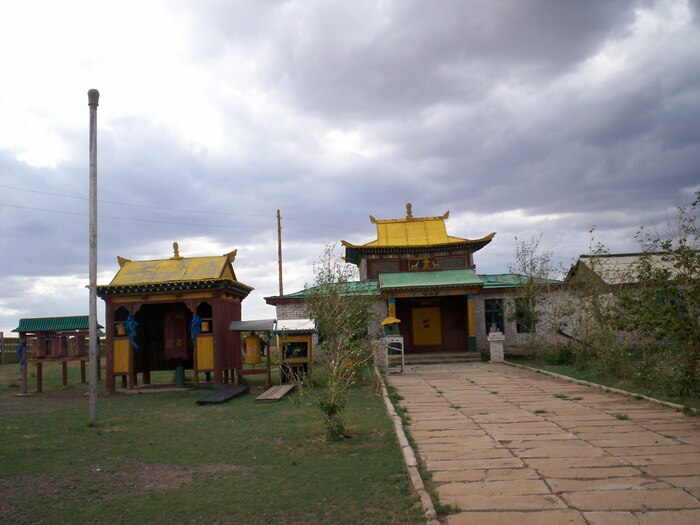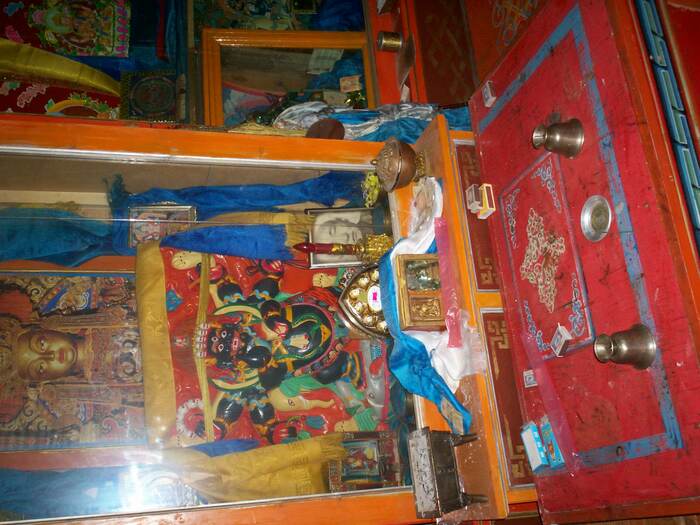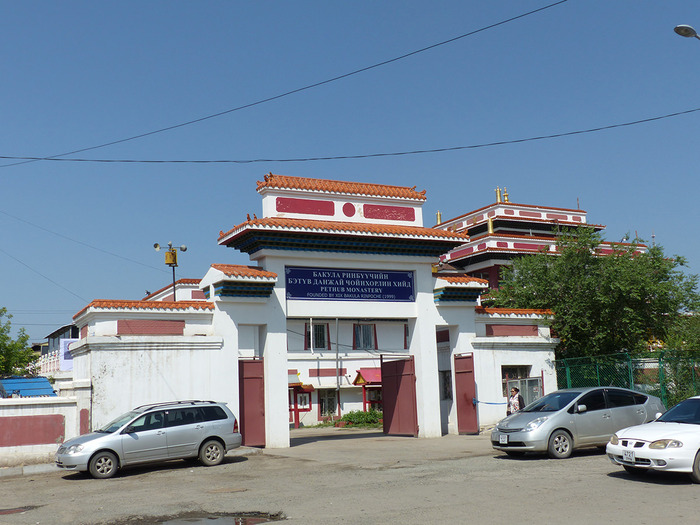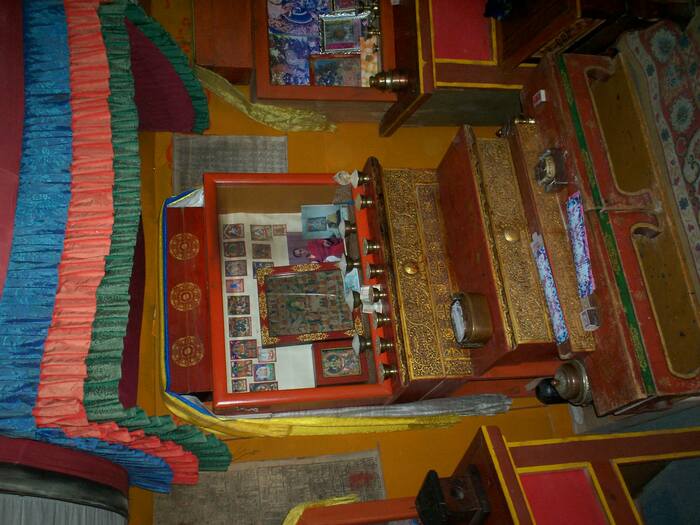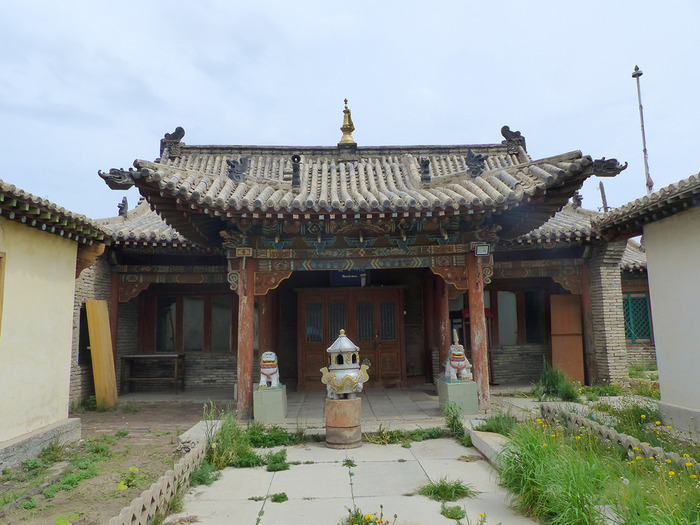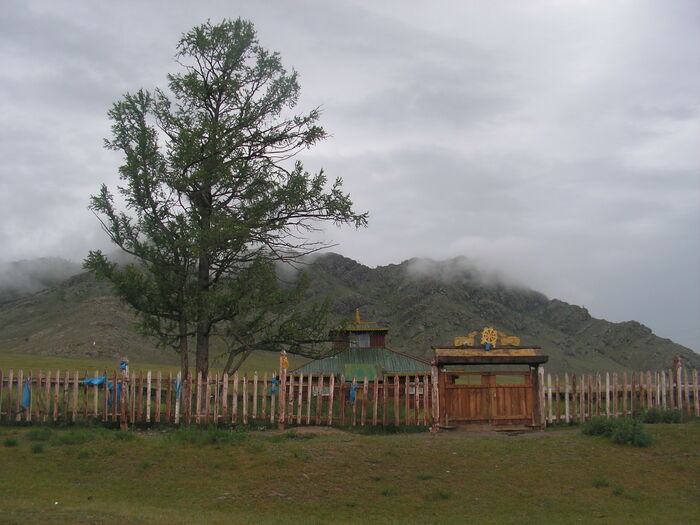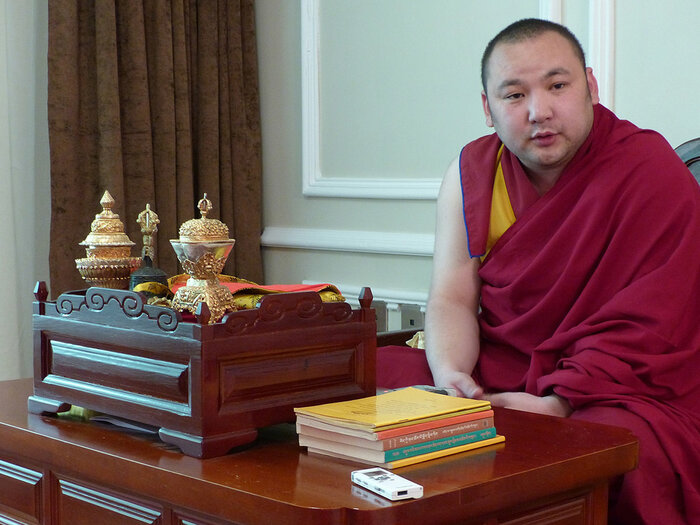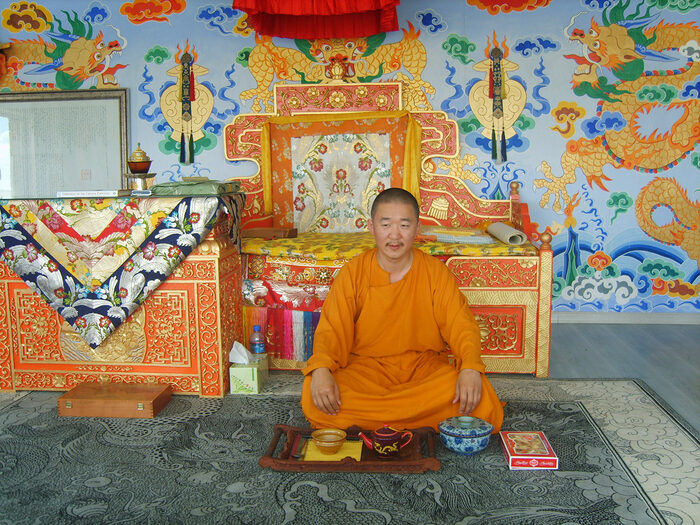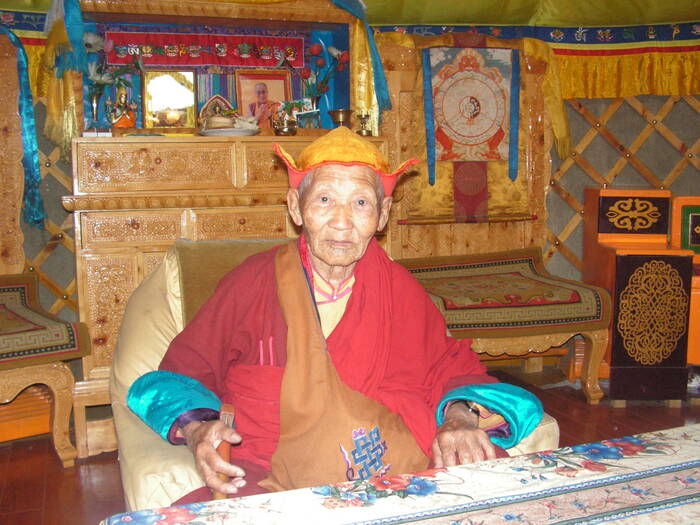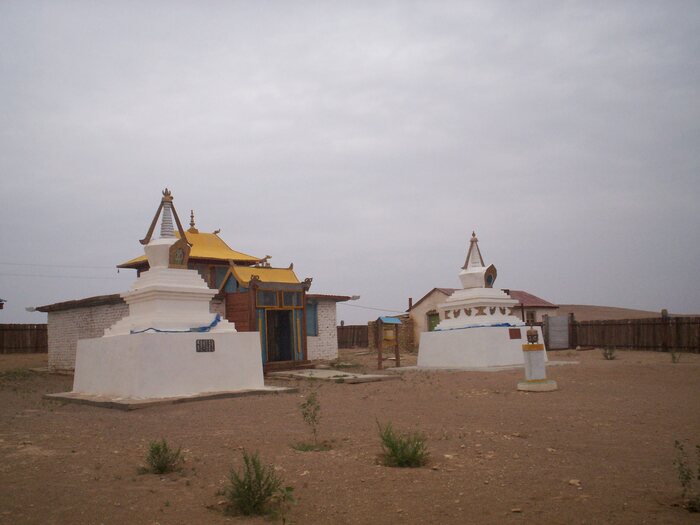Introduction
Only after the 1990 Democratic Revolution was the practice of Buddhism permitted in public in Mongolia. Mongolians were now able to practice Buddhism freely. From the first protests in December 1989, through the subsequent protests that followed, until the first democratic elections in July 1990, the protesters demanded democracy, freedom of press, respect of human rights, and freedom to practice religion. They also called for the rehabilitation (Khal. tsagaatgakh, Mong. čaγadqaqu) of the old ex-lamas, the survivors of the so called “Mongolian Purges,” also called the “Repressions” (Khal. khelmegdüülelt, Mong. kelmegdegülelt), and those that were executed and their families. “Lama” is the traditional Mongolian way of referring to a monk.
In the main monastery, Gandan or, more fully, Gandantegchenlin (Mong. γangdangtegčenling, Tib. dga’-ldan thegs-chen gling), which had been partly reopened since 1944, religious ceremonies were renewed, rituals and practices were revived or reintroduced in their full forms, monastic education was reorganized according to the traditional system, and teaching at its university was expanded. Monasteries, temples and Buddhist institutes were soon reopened or newly established in the capital and throughout the country. Those ex-lamas who had survived the purge played the main role in the revival. However, as soon as the temples began to be reopened, different international Buddhist organizations appeared and offered their help both financially and in the education of the next generation of Mongolian lamas. Principal among them were Tibetan Buddhist organizations from India, Nepal and the USA.
The Role of the Old Ex-Lamas
As mentioned, the revival in Ulaanbaatar as well as in the countryside was led by the elderly ex-lamas, then in their 60 and 70s, who had avoided execution. They survived only by being young enough at the time of the purges that they had either been sent to schools instead of to prisons or they were not yet highly educated or advanced in their monastic studies and so did not hold high ranks or titles at that time. High-ranking and highly trained lamas had been specifically targeted during the purges, so very few of them had avoided execution and had survived. In spite of this, there were still some highly trained lamas among the leaders of the revival who had held high ranks before 1937. The revival of Mongolian Buddhism was based on their memories and devoted activities.
Until proper temple buildings were built or possession of the few temple buildings that had survived was regained and they were restored, these old ex-lamas gathered in private yurts or in rooms of state buildings. They also brought to light the old Tibetan books, sacred sculptures, images and old ritual accessories that they had hidden either in secret places or, when the consequences of being discovered by the authorities became less severe over time, in their homes. The first newly opened temples were equipped in this way.
The old ex-lamas soon started to accept students. It was not rare that advertisements for recruiting young novices appeared on temple doors or in the local press. It was also not rare during this early period that newly entered novices left the state educational system and thus lacked proper secular education. The question of providing state education parallel to monastic education was only solved later.
In the newly opened temples, daily recitation of texts and monthly and annual rituals were gradually restarted. Among the rituals restarted were those they had practiced secretly during the repression, as well as those practices and local special rituals that they remembered from before the monasteries were ruined in 1937. All of this happened step by step as financial means and other circumstances allowed and the number of lamas in the assemblies grew. By the 2010s, this generation of ex-lamas had passed away. Since then, their students and those who graduated before 1990 from Gandan’s Buddhist College or later University have taken the active role in training today’s novice generation.
Often the newly revived temples bore the names of the old monasteries. If it was not possible to revive a monastery at its old site, it was often revived under the same name in the subprovincial (Khal. sum, Mong. sumun) or provincial (Khal. aimag, Mong. ayimaγ) center. The monasteries and temples adopted the main central statues (Khal. gol shüteen, Mong. γool šitügen, Tib. rten, literally “basis, support”), the main Dharma protectors (Khal. gol sakhius, Mong. γool sakiγu(l)sun, Tib. srung-ma / bstan-bsrung, chos-srung, chos-skyong, Skt. [dharma]pāla) and the main meditational deities or yidams (Khal. gol yadam, Mong. γool idam, Tib. yi-dam, Skt. iṣṭadevatā) as had been venerated in their ruined old counterparts. In addition, measures were taken to revive the recitations, rituals and practices connected with these wherever there were old ex-lamas who could transmit them.
From the very beginning, the rituals that were revived – with the emphasis placed on reviving the actual local readings and practices of the revived old monasteries – started with shorter ones, primarily daily recitations and monthly rituals such as those of the Medicine Buddha (Khal. manal, Mong. manal / man lha, Tib. sman-bla, Skt. bhaiṣajyaguru), Tārā (Khal. dar’ ekh, Mong. dar-a eke, Tib. sgrol-ma), and the Dharma protectors (Khal. sakhius). Dharma protectors were also called “untamed, wild, fierce ones” (Khal. khangal, Mong. qangγal, Tib. drag-po, Skt. raudra) and “fierce destroyers” (Khal. dogshid, Mong. doγsid, Tib. drag-gshed). Restarting other, more extensive rituals was only possible gradually. This was due to the fact that the most knowledgeable lamas who could transmit them and train the young lamas in performing them had been killed in the purges. It was also due to financial problems, making it impossible to obtain, make and maintain all the necessary equipment for them. Also, most of the newly opened monasteries or temples lacked the requisite number of lamas for holding these rituals. Therefore, it took years or even decades to restart complex rituals such as the Maitreya circumambulation (Khal. maidar ergekh, Mong. maidari ergikü) and the 45-day summer retreat (Khal. khailen or yar khailen, Mong. yar qayilan, Tib. dbyar khas-len; summer commitments), not to mention the masked ritual dances (Khal. tsam, Mong. čam, Tib. ’cham(s)). These so-called “lama dances” have been revived fully only in three monasteries up until now: Amarbayasgalant (Mong. amurbayasqulang-tu) in Selenge province since 2001, Züün Khüree Dashchoilin (Mong. ǰegün küriyen / küriye dašičoyiling, Tib. bkra-shis chos-gling) in Ulaanbaatar since 2002, and the Gandantegchenlin main monastery since 2016, after one earlier occasion in 1999.
The role of these old ex-lamas was crucial in all of these, as the only chance to realize the revival was by the help of these mostly already married old lamas who still knew the local Mongolian Buddhist traditions and the specially “Mongolized” rituals – ceremonies specific to Mongolian Buddhism, with their unique melodies and many other special details. Without these specifically Mongolian features and with lamas coming from outside Mongolia – mainly from the Indian monasteries and institutions of the Tibetan tradition in exile in India – the renewal of Buddhism would only have been a conversion of the Mongolians to Tibetan Buddhism and not a “revival” of the Mongolian Buddhist traditions. The names, activities, and roles of these old ex-lamas in the revival are still vividly remembered in their local communities.
The Role of Foreign Monks, Foreign Buddhist Institutions, and International Organizations
As the revival began, funds for reestablishing the rituals, reconstructing ruined monasteries, and building new temples came mostly from individual donors. In many local places, subprovincial centers and so on, movements for collecting funds for these purposes sprang up immediately. Donors included laypeople, surviving old ex-lamas as well as their families, and descendants of lamas who had been executed or who had passed away. Local businessmen, local authorities, even local party leaders offered help and gave generous donations. Local herdsmen donated what they had, offering animal products and food. Gandan Monastery and the Mongolian State also contributed. At the same time, help started to arrive from various Buddhist organizations abroad – mainly from Buddhist organizations and Tibetans living in exile. This was very much needed. Several of these organizations are still present today and are continuing their work.
Several highly esteemed Rinpoches (Khal. rinbüüchi, Tib. rin-po-che, Precious One, title for distinguished or incarnate lamas) from outside Mongolia also embraced the Buddhist revival movement. They played a major role in providing financial means for the reconstruction and had their own impact on the revival. There were two in particular, Bakula Rinpoche and Gurudeva Rinpoche.
The Ladakh-born Kushok Bakula Rinpoche (1917–2003), or as known in Mongolian, Bakula Rinbüchi, the nineteenth reincarnation of his line, was a Geshe Lharampa (Khal. gewsh lkhaaramb, Tib. dge-bshes lha-rams-pa, holder of the highest academic degree in Buddhist philosophy) from the Tibetan Drepung Loseling College (Khal. drepung losalin datsan, Mong. drepung losalin dačang, Tib. ’bras-spungs blo-gsal-gling grwa-tshang). He was considered to have been the incarnation of one of the sixteen arhats (Khal. naidan, Tib. gnas-brtan), Buddha’s main disciplines. He was the Indian ambassador to Mongolia from 1990 to 2000. During his years as ambassador, he contributed immeasurably to the revival of Buddhism and Buddhist institutions in Mongolia.
Apart from regular teachings in Ulaanbaatar, Bakula Rinpoche spent his time travelling all over the country giving teachings. Well before becoming ambassador, he first visited Mongolia in 1970 during the communist period at the invitation of the Asian Buddhist Conference for Peace (ABCP) (Khal. Aziin Buddistuudyn Enkh Taiwany Baga Khural). He had been visiting Mongolia and Buryatia regularly since then, able to give teachings even in those difficult times, and contributing to the Buddhist revival in Kalmykia as well. At the request of the Dalai Lama, Richard Gere sponsored the publication of some of Bakula Rinpoche’s lectures in colloquial Khalkha Mongolian in 1997. Organized by Dr. Alexander Berzin and managed by Bakula Rinpoche’s assistant Sonam Wangchuk, it was one of the first publications of Buddhist teachings in the colloquial language.
Bakula Rinpoche urged the return to the original vinaya rules of monastic discipline and also emphasized that having a proper residential environment enhances ethical purity among lamas. In Ulaanbaatar, he founded the only monastery that is fully residential up until now, Betüw Khiid, known also by its long name as Betüw Danjai Choinkhorlin Khiid (Tib. dpe-thub bstan-rgyas chos-’khor gling, Pethub Tangye Choskhorling Monastery). Inaugurated in the summer of 1999, the residential building was completed and opened in 2006. His plan was for it to serve as a model and example for future Mongolian monasteries. His new reincarnation was enthroned in this monastery in the summer of 2017.
The other famous Rinpoche contributing to the revival of Mongolian Buddhism was Gurudeva Rinpoche (1908–2009), a highly esteemed monk of Inner Mongolian origin, born in Ordos. From the age of 20, he studied in Tibet at Drepung Gomang Monastery (Khal. drepung goman datsan, Mong. drepung γoman dačang, Tib. ’bras-spungs sgo-mang grwa-tshang). With the Chinese takeover of Tibet, he became a refugee in India. However, he came into conflict with the Dalai Lama over the worship of a protector deity, Shügden (Shugden, Tib. Shugs-ldan), banned by the Dalai Lama, and was consequently forced to leave India for Nepal. From there, for the same reason, he emigrated to Mongolia in 1991.
He contributed greatly to the revival, restoration and reopening of temples in Mongolia but, at the same time, spread the controversial cult of Shügden. The main monasteries rebuilt from his funds are Amarbayasgalant in Baruunbüren, Selenge province. It had originally been built by the Manchu Yongzheng Emperor (Khal. nairalt töw, Mong. nayiral-tu töb, 1722–1735) for the remains of Öndör Gegeen Zanabazar (Mong. öndür gegen < gegegen ǰanabaǰar, 1635–1723). He also supported the rebuilding of Delgeriin Choir Monastery (Mong. delger-ün čoyir-a) in Delgertsogt, Dundgow’ province, the old monastery of Zawa Damdin Rinpoche, who was also known as Zawa Lam or Zawa Damdin Luwsandamdin (Mong. ǰaba damdin, Tib. rtsa-ba blo-bzang rta-mgrin, 1867–1937).
In 2000, Gurudeva Rinpoche, or as known by the Mongols, Gürüdewa Rinbüchi, selected and recognized the reincarnation of Zawa Lam. He was the only Mongolian tulku (Tib. sprul-sku, reincarnated lama) recognized by neither the Dalai Lama nor the Bogdo Gegen or Bogdo Gegegen (Khal. Bogd gegeen, Mong. Boγda boγda gegen < gegegen, the traditional head of Mongolian Buddhism). Partly educated, along with several other Amarbayasgalant lamas, in Switzerland at Rabten Choeling Monastery, where Shügden is practiced, he secured funds from there for his monastery back in Mongolia. In 1993, Gonsar Rinpoche, the abbot of Rabten Choeling, had been appointed as abbot of Amarbayasgalant. The previous incarnation of Gonsar Rinpoche had been the abbot of Amarbayasgalant for 40 years before its destruction.
Gurudeva Rinpoche also funded a Women’s Center (Khal. emegteichuudiin khural) in Ulaanbaatar, Tögsbayasgalant (which name is the translation of the Tibetan term, Tib. dga’-ldan). His participation in the founding of all these institutions also meant that Shügden has become venerated in all of these monasteries and assemblies. In addition, he also sponsored and collected funds from South Koreans for a 23-meter statue of Shakyamuni Buddha at the foot of Zaisan hill in Ulaanbaatar in 2006.
In addition to these two Rinpoches, various foreign organizations and Buddhist institutions offered help from the very beginning – not only Tibetan ones from India but others from Europe, North America, and Asian Buddhist countries such as Taiwan, Japan, Nepal, Hong Kong, South Korea, and India. These included organizations of Buddhist traditions other than Tibetan ones. Although these Buddhist organizations have helped greatly to fund the revival, the continuous presence of them was still a foreign impact on what is called “Mongolian Buddhism” with its uniquely Mongolian features in its recitations, its rituals and its monastic life as revived by the old Mongolian ex-lamas who survived the purges and communist period. These foreign Buddhist organizations have exerted an influence in the way that Buddhism has developed during this revival period by introducing different lineages and practices not previously present in Mongolia and by requiring the keeping of strict monastic discipline, an issue being handled differently in Mongolia. The most important of them has been The Foundation for the Preservation of the Mahayana Tradition (FPMT), which is still continuing its activities today (2023).
The Foundation for the Preservation of the Mahayana Tradition belongs to the Tibetan Gelug tradition. Founded in the early 1970s by Lama Thubten Yeshe (Tib. thub-bstan ye-shes, 1935–1984) and Lama Thubten Zopa Rinpoche (Tib. thub-bstan bzod-pa, 1945–2023), known as Söpa Rinbüüchi in Mongolian pronunciation, it opened its first center, Ganden Do Ngag Shedrub Ling Dharma Center (Tib. dga’-ldan mdo ngag bshad-sgrub gling), in Ulaanbaatar in 2000. A second center, the Golden Light Sutra Center, was opened in Darkhan in 2005 but has been operating from 2020 as a Study Group.
FPMT Mongolia has sponsored the rebuilding of one of Gandan’s monastic colleges, Idgaachoinzinlin Datsan (Tib. yid-dga’ chos-’dzin gling grwa-tshang), completed in 2003, and since then, has been providing funds for the food of the lamas residing there through its Mongolian Sangha Fund. They have also rebuilt Dar’ Ekh Khiid, also known as Dulmalin Khiid (Tib. sgrol-ma gling btsun-dgon) in the remained buildings of an old Chinese monastery on the western side of Ulaanbaatar in 2001−2003. Previously, in 1991, two Gandan lamas had established a community of Buddhist women there and had carried out some restoration of the main temple. It has been turned into a residential nunnery with resident teachers coming from the nunnery of Kopan monastery in Nepal. FPMT also runs different charity programs as well under their “Lamp of the Path NGO,” similar to several other foreign Buddhist organizations.
Along with the Buddhist organizations, foreign NGOs have also contributed in their own way to the revival of Buddhism in Mongolia. For example, the London-based Tibet Foundation (founded in 1985, closed in 2021) worked on reconstituting Buddhist traditions in Mongolia through its “Buddhism in Mongolia” project. For a period, they had their offices in the monastery of Bakula Rinpoche. Besides different other projects in Mongolia, they also sponsored Mongolian lamas to study in India and several Mongolian lamas to earn an MA degree at universities. In addition, they made donations to enrich monastery libraries.
Although the reconstruction of ruined but partially standing monasteries and the construction of several new temples were nationally and locally supported, different foreign and international organizations, such as UNESCO, as well as different Buddhist organizations and NGOs have provided considerable help. These organizations include the Mongolian Buddhism Revival Project of Kunzang Palyul Choling (KPC) and the Gaden Relief Project.
The Mongolian Buddhism Revival Project of Kunzang Palyul Choling (Tib. kun-bzang dpal-yul chos-gling) is an American Nyingma organization of Penor Rinpoche (Tib. pad-ma nor-bu, 1932–2009). It sponsored the rebuilding of Khamryn Khiid (Mong. qabar-un keyed) in Sainshand, Dornogow’ province. It is the reconstitued monastery of Danzanrawjaa (Tib. bstan-’dzin rab-rgyas, 1803–1856), the Fifth Noyon Khutagt, who was a prominent Mongolian Buddhist tulku, scholar, writer, composer, and painter. This organization also sponsored young lamas from there to study in Penor Rinpoche’s Namdroling Monastery (Tib. rnam-sgrol-gling) in Bylakuppe, South India and young women to study in the neighboring nunnery, Tsogyal Shedrup Dargyeling (Tib. mtsho-rgyal bshad-sgrub dar-rgyas-gling).
The Gaden Relief Project is a volunteer Canadian non-profit organization of the Gelug lama Zasep Rinpoche, a Shügden practitioner and student of Gurudeva Rinpoche. It donated funds for the restoration and rebuilding of Amarbayasgalant and Delgeriin Choir Monasteries and for improving the infrastructures for their water and energy supplies and for building residential facilities. They have also funded the studies of Amarbayasgalant lamas in Switzerland and given help to Tögsbayasgalant Women’s Center.
Some other projects were only aimed at rebuilding and renovating but did not include other forms of support. For example, between 1999 and 2006, volunteers from the Cultural Restoration Tourism Project (1996–2008) restored Baldan Baraiwan / Bereewen Monastery (Tib. dpal-ldan ’bras-spungs) in Ömnödelger, Khentii province. By 2007, the Tibet Heritage Fund (THF) had restored the six remained temple buildings of Sangiin Dalai Monastery (Mong. sang-un dalai) in Nomgon, Ömnögow’ province.
As we have seen, it was also thanks to these foreign organizations, NGOs, exceptional supporters and high lamas that the first opportunities opened up for young Mongolian lamas and some women to study in the Tibetan monastic universities and institutions of India. In addition, a small number have been able to study in Tibet at Kumbum (Khal. Gumbum, Tib. sku-’bum) and Labrang (Khal. Lawran, Tib. bla-brang) Monasteries and also a few in Buddhist monasteries in Europe. In some cases, as seen from some of the above examples, the foreign institutions where they were sent were specific to the Tibetan tradition to which the funding Buddhist Organization belonged.
The possibility to study abroad was especially important in this period, as the newly revived monasteries in Mongolia needed time to gradually redevelop and open new possibilities for traditional monastic education after all such institutions had been destroyed in Mongolia and the traditions of monastic education had been broken for such a long time. The intention was and still is that these highly educated lamas will return to Mongolia to pass on their knowledge locally to a younger generation of lamas. At the beginning, most of those who studied abroad were able to spend only a single year or several years there, but later a few were able to study the monastic curriculum for ten years. They have returned by now and are teaching in Mongolia. Study in the monasteries in India was also important from the point of view of the monastic vows, as there, in contrast with their prior time in Mongolia, the lamas lived in monastic residences keeping the monastic regulations and vows.
Several of these foreign Buddhist organizations, led by different Tibetan lamas, also opened centers in Mongolia in addition to their funding activities, similar to what FPMT has done. These centers, as all such centers in Europe, North America, and Australia, have focused their activities on laypeople, providing Buddhist educational lectures and meditation courses for them. This was contrary to what was traditional in monastic Buddhism or in the revived Mongolian Buddhist monasteries and temples. It was only later that Mongolian Buddhist centers opened that also concentrated on laypeople and that several of the biggest monasteries also started courses for lay devotees.
Christian Missionaries after the Revival
The newly gained religious freedom also meant that various religious groups could also enter Mongolia freely. The majority were various Christian missionary groups, mainly from the United States and South Korea. They often had extensive charity programs and widely attracted the youth in many ways, such as by teaching English through the medium of Christian literature. On top of that, in the first years after the 1990 Democratic Revolution, in the face of a lack of Buddhist publications in Cyrillic Mongolian, their Christian materials were more easily available.
What also made a difference at that time was that, in the first years following the Buddhist revival, there was as yet no training available in Buddhist studies and meditation for interested laypeople. That development in Tibetan Buddhism occurred only after the Tibetans were forced into exile in India in 1959, with many going to the West, but it was not part of the traditional monastic life either in Mongolia or Tibet.
Later, several institutions and Dharma centers, following Western pattern, also opened in Mongolia for this purpose. Basic Buddhist texts have been translated and published in modern colloquial Khalkha Mongolian. However, as these foreign missionary groups were usually well funded, they had the advantage in the first decades and several built churches even in subprovincial centers where there were not yet any revived Buddhist temples.
Mongolian Organizations That Helped with the Revival
With the 1990 Democratic Revolution, different Mongolian associations and organizations were also set up with the aim of funding and advancing the revival. The most important one was the Association of Mongolian Believers (Khal. mongol süsegtnii kholboo), headed by S. Bayantsagaan. It facilitated the founding of about 85 monasteries and temples in Mongolia – for instance, the Lamrim Datsan Monastery, also known as the Janchub Lamrim Datsan (Tib. byang-chub lam-rim grwa-tshang), in Ulaanbaatar.
Another such organization was the Railway Association of Mongolian Believers (Khal. tömör zamiin süsegtnii kholboo). It facilitated the opening of the Nyingma Monastery Puntsoglin Khiid, or Puntsoglin Datsan (Tib. phun-tshogs gling). Further in this period, the leaders of Dashchoilin monastery started the Mongolian Association of Young Buddhists (Khal. mongoliin burkhanii shashint zaluuchuudiin kholboo) for young lamas and students from Mongolian colleges and universities. Many similar local organizations were also founded in provincial and subprovincial centers with the specific aim of rebuilding and supporting the operation of a given Ulaanbaatar or countryside monastery. All these national and local organizations played a major role at the start of the revival in funding the operation of the newly opened monasteries and temples.
Recognizing the Bogdo Gegen and Other Mongolian Tulkus
After the fall of the Manchu Qing dynasty, the Eighth Bogdo Gegen or Jebtsundampa Khutugtu (Khal. jewzundamba khutagt, Mong. ǰibǰundamba qutuγtu) (1869–1924), proclaimed Mongolian independence and became not only its religious leader but also its secular leader from 1911 to 1921. He was the first and only one of his line to bear the title “Bogdo Khan” (Mong. boγda qan), “Masterly Khan.” After his death in 1924, Mongolian Buddhism did not have a new head. The search for his reincarnation (Khal. khoid dür todruulakh) was even forbidden in 1929. With several severe waves of suppression, followed by the 1937/38 destruction of the monasteries and mass executions, any religious activities remained impossible for decades until the 1990 Democratic Revolution. For this reason, it took a long time before the question of the Ninth Bogdo Gegen could be dealt with in Mongolia.
However, outside Mongolia, the Tibetan boy Jampal Namdol Chökyi Gyaltsen (Khal. jambalnamdolchoijijantsan, Tib. ’jam-dpal rnam-grol chos-kyi rgyal-msthan) (1932–2012) was recognized in 1936/37 at the age of 4 by Reting Rinpoche (Khal. Raden rinbüüchi, Tib. rwa-sgreng rin-po-che) as the reincarnation and thus the Ninth Bogdo Gegen. He emigrated to India in 1961 and lived in Dharamsala from 1991.
For a long time, his name was kept secret and, due to the long decades of suppression, there was no possibility to bring him to Mongolia and establish him as the actual head of Mongolian Buddhism. After the 1990 Democratic Revolution, however, his position was strengthened by his enthronement (Khal. sentiid zalakh, “invitation to the lion throne,” the first part of the expression being the Tibetan word seng-khri, lion throne) by the Dalai Lama in 1992. At this ceremony, he was given the legal document of his title.
He first came to Mongolia in 1999, where he was once more enthroned and acknowledged by the Mongolian Buddhist establishment of Gandan as the Ninth Bogdo Gegen. His visa, however, expired soon afterwards and he had to return to India. Living in Dharamsala, he had numerous Mongolian as well as Tibetan students. Later, the President of Mongolia, Ts. Elbegdorj, invited him to Mongolia in 2009, granted him Mongolian citizenship in 2010, and officially acknowledged him as the head of Mongolian Buddhism (Khal. mongol burkhan shashny tergüün) in 2011. The Ninth Bogdo Gegen passed away at the age of 81 in Mongolia at the beginning of March 2012 after his health had rapidly deteriorated. Thus, he only resided in Mongolia for the last years of his life. After his death, Mongolians have had to wait for his successor, the Tenth Bogdo Gegen, for more than a decade.
In the absence of a Bogdo Gegen residing in Mongolia, it was necessary to have other spiritual dignitaries to oversee the lamas and devotees in religious affairs. So, the search for and recognizing the reincarnations (tulkus) of other Mongolian eminent lamas started soon after the revival. Several of these tulkus were related to specific monasteries or lineages and were searched for following the official request of the local assemblies and communities. In colloquial Khalkha Mongolian, tulkus are called “khuwilgaan” (Mong. qubilγan, Tib. sprul-sku, Skt. nirmāṇakāya), Reincarnate Lama, and some hold titles such as “khutagt” (Mong. qutuγtu, transliterated in Tibetan as ho-thog-tu, Tib. ’phags-pa, Skt. ārya), Highly Realized One or “gegeen” (Mong. gegen < gegegen), alternately “gegeenten” (Mong. gegenten < gegegenten), Brilliant One.
The recognition and installation of tulku reincarnations lies in the hands of lamas higher in their position and rank. In the case of Tibetan tulkus, the Dalai Lama or the Panchen Lama have this role, but in the case of Mongolian tulkus, the Bogdo Gegen can also take on this responsibility. After the 1990 Democratic Revolution, except for one tulku recognized by Gurudeva Rinpoche, the Mongolian tulkus were recognized mostly by the Fourteenth Dalai Lama, with several also by the Ninth Bogdo Gegen. The current Eleventh Panchen Lama was kidnapped in 1995 by the Chinese authorities at the age of six, only three days after his recognition, and so has been unable to assume any of his official roles.
Among the first Mongolian tulkus installed were:
- The Seventh Zaya Gegeen Luwsandanzanpüljinjigmed (Tib. bstan-’dzin phul-byung ’jigs-med), recognized by the Dalai Lama in 1999 in Arkhangai province,
- Zawa Damdin Rinpoche D. Osgonbayar, recognized by Gurudeva Rinpoche in 2003 in Ulaanbaatar,
- The Ninth Jalkhanz Khutagt Danzanchoijiwanchug (Tib. bstan-’dzin chos-kyi dbang-phyug), recognized by the Dalai Lama and the Ninth Bogdo Gegen in 2006 in Zawkhan,
- Jonang Khanchen Gegeenten Luwsanchoidog (Tib. jo-nang mkhan-chen blo-bzang chos-grags), recognized by the Dalai Lama and the Ninth Bogdo Gegen in 2006 in Dharamsala, India,
- The Seventh Manzshir Khutagt Danzanjamiyandorj (Tib. bstan-’dzin ’jam-dbyangs rdo-rje) recognized by the Ninth Bogdo Gegen in 2009 in Töw province,
- The Eighth Lamyn Gegeen Danzanjambalchoijishinen (Tib. bstan-’dzin ’jam-dpal chos-kyi bshes-gnyen) recognized by the Dalai Lama in 2010 in Bayankhongor.
These Mongolian tulkus were sent to India for their studies, and since then, several have returned to Mongolia and have taken up residence in their temples at the sites of their old monasteries in the countryside or established their own temples in Ulaanbaatar. Some of them have already passed away by today (2023) – for example the Seventh Zaya Gegeen in 2019.
Gandan Monastery after 1990 in the First Period after the Revival
After the passing of Kh. Gaadan, Sh. Dagwadorj held the position of abbot of Gandan Monastery between 1990 and 1991. T. Damdinsüren succeeded him as abbot between 1991 and 1993. D. Choijamts then became the head abbot (Khal. tergüün khamba) in 1993 of not only Gandan but also of all the Mongolian Buddhists. He is still in office (in 2023).
In the first period after the revival, old ex-lamas, such as Yo. Amgalan and G. Dewaasambuu served in different positions in the monastery. Choijamts became vice-abbot (Khal. ded khamba) in 1986, before the revival. He held this position until 1990. He was among the first lamas in Mongolia who, when the Democratic Revolution came, stood and passed the “examination in the ten difficult texts” (Khal. gawjiin damjaa, Mong. γabǰu / γabǰi-yin damǰiya, Tib. dka’-bcu’i dam-bca’).
After the revival, Gandan Monastery remained the center for Buddhists in Mongolia with its nine main buildings in a fenced-off courtyard. Some of them survived the destruction while others were rebuilt after the revival. Later, additional ones, as well as a new huge main assembly temple, were constructed. Over time, the monastic community grew to around 500 lamas belonging to the different temples and to the rebuilt and reopened monastic colleges in the complex. There, the traditional monastic education was also revived step by step. The huge 16-meter-high statue of the standing Avalokiteśvara (Khal. Janraiseg, Mong. ǰanrayisig, Tib. spyan-ras-gzigs) has been reconstructed in the temple building in which it had originally stood, and which had survived.
As Gandan Monastery had remained a functioning monastery, even though heavily controlled, for all but six years in the communist period, traditional ceremonial activities could be revived here more easily than in newly opened smaller temples and monasteries. Accordingly, many monthly and annual ceremonies started to be held in Gandan once more. Being the main monastery, Gandan attracts masses of people daily who come for worship and for making prostrations and offerings. These devotees also request the recitations of texts here, which is a main source of income for this and the other Mongolian monasteries.
Other Ulaanbaatar Monasteries
Apart from Gandan, many other monasteries and temples opened in Ulaanbaatar in the 1990s, right with the Democratic Revolution and in the subsequent years. In these first years, it was mainly old ex-lamas who initiated their founding, but in many cases, younger lamas became their heads, with the old ex-lamas filling the other main ranks in the assemblies. As the years passed, younger lamas from the reopened temples, after studying and gathering in them for many years, started to open their own temples, with many in Ulaanbaatar. Connections between the individual monasteries and temples were often established in this way.
Some of the lamas, after finishing their studies at Zanabazar University/College of Gandan (Khal. Mongolyn Burkhany Shashintny Töw Gandantegchenlin khiidiin dergedekh Öndör Gegeen Zanabazaryn neremjit Mongolyn Burkhany Shashny Deed Surguul’), also founded their own temples. Thus, in the 2010s, the number of temples in Ulaanbaatar grew gradually to between 40 and 50, and even today new temples are still being opened.
It is also important to mention that among them many small temples were also opened that had only less than four lamas. These, however, seem not to be more than private enterprises as they mainly perform recitations of texts and rituals at the request of individuals besides their schedule of daily and, perhaps, monthly rituals.
Countryside Monasteries
In contrast with the Ulaanbaatar temples, most of the temples that opened in the countryside were old monasteries that had been revived, even if not on their original sites in lack of any remained buildings. Their reopening was mainly due to the initiative and efforts of their old ex-lamas. It was an extremely rare case that any temple building had survived intact and was still suitable for ceremonies from the start. Despite this, the old ex-lamas tried to revive the ceremonies, wherever possible, at the actual old monastic sites themselves, in any remaining building there after some renovation, or in a yurt temporarily put up at the site while trying to secure funds for rebuilding at least one temple there from local donations or from national or foreign funds.
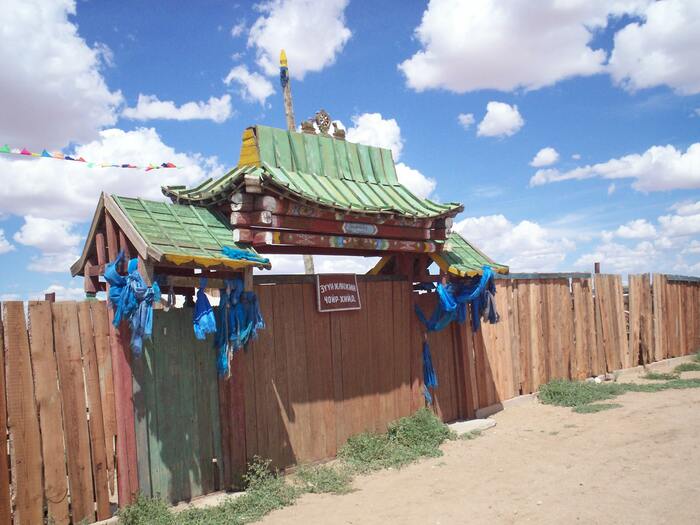
In some cases, where there were no remaining temple buildings or it was impossible for some reason at the old site, rituals were started in the provincial and subprovincial centers instead – in any place they could secure for these gatherings: a room in the local cultural center, a school building, or even in a yurt. In the case of some old sites with larger lama populations in the past, it was not rare that 40 or 50 old ex-lamas participated in the reopenings around 1990, while in isolated places, sometimes only one or two lamas tried to revive the faded traditions and rituals.
It was also not rare for several of the monasteries that had partly survived countrywide to remain as museums or to be turned into museums and for them not to be given back to the local assemblies for their religious use. Some examples are the temples of Zaya Gegeenii Khüree in Tsetserleg, Arkhangai Province and some temple buildings in Erdene Zuu, Kharkhorin, Öwörkhangai Province.
The restoration of old monasteries and temples or the opening of new monasteries and temples is one thing, while another, more different thing is keeping them actively operating with an assembly and an adequate number of appropriately trained lamas. In the first one or two decades after the revival, old ex-lamas could still be present in the assemblies, although in decreasing numbers, and the younger ones were mainly trained locally, with a few exceptions who had the possibility to study in India or in Ulaanbaatar. The later fate of the countryside assemblies depended on the calling and education of these young lamas, their willingness to later stay in or return to their often remotely situated home temples, and the generosity of the donors who provided their financial support.
